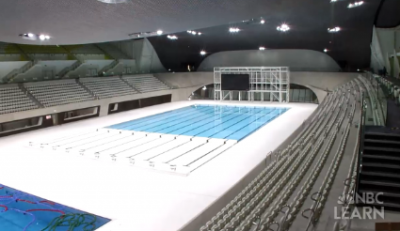Science of the Olympics – Designing a Fast Pool with NBC Learn
All swimming pools are alike, right? A concrete box filled with water and lane markers.
Did you know the Olympic Aquatic Center in London was designed to be fast for the world’s best swimmers like gold medalists Michael Phelps and Missy Franklin? This isn’t your neighborhood pool.
The London Aquatic Center, with its wave-like roof is one of the most technologically advanced pools ever built.
How is a “fast” pool designed? By starting with the elimination of waves.
A wave is a disturbance that travels through a medium and is a means of transferring energy. Sound waves transmit the energy of a noise through the air. Seismic waves transfer the energy of an earthquake through the ground.
How difficult is it to swim in rough seas vs a calm ocean? The waves carry energy that the swimmer must over come. Olympic swimmers want all of their energy to go towards speed and winning, not battling waves in the pool.
As the swimmers jump off the starting blocks and into the water, some of that energy is carried away on the waves. Every time a swimmer creates a disturbance in the water by kicking their feet or taking a stroke, they put energy into the water and create waves.
The pools at the Aquatic Center were designed to dissipate the energy and minimize the waves. The technology is found all around the pool. For starters, the bottom of the pool is adjustable to various heights. During the swimming races, the bottom is set to three meters (10 feet) beneath the surface. This is deep enough to cause the waves to break apart and dissipate before they hit the bottom of the pool to bounce up and hit the swimmers.
The sides of the pool are lined with a trough that swallows waves before they can rebound back into the lanes.
The pool is 25 meters (82 feet) across. This gives each lane a width of 2.5 meters (8 feet). The size of each lane helps to reduce wave energy by giving extra space for it to dissipate.
The lane lines are also high-tech. They decrease the wave energy before it travels into the next lane. When a wave hits the lane line, it spins, taking the energy and slowing the wave.
Even with all of the technology, the pool will still have waves. That is why the outer lanes are usually left empty. It is different to swim next to the wall vs in the middle of the pool.
This Olympic season, NBC Learn has once again put together some very educational and informational videos on the science behind the Olympics. If you are looking for some great material for your classroom, homeschool group or extra knowledge, check out all of their videos at NBCLearn.com/Science of the Summer Olympics.






Leave a Reply
Want to join the discussion?Feel free to contribute!